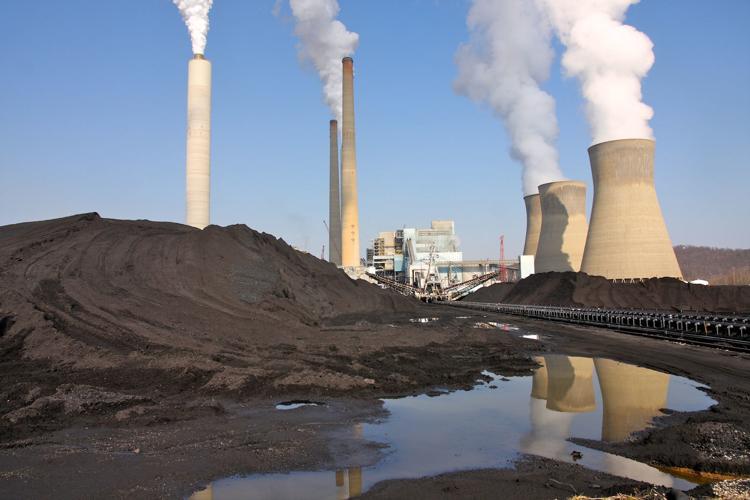Greenhouse gases kill. The United States is one of the world����ֱ���s most prolific polluters of them.
But the U.S. Environmental Protection Agency has proposed finding that greenhouse gas emissions from fossil fuel-fired power plants don����ֱ���t contribute significantly to dangerous air pollution.
The EPA has paired that proposal with a new plan, cheered by West Virginia political leaders, to repeal all greenhouse gas emissions standards for the power sector under Section 111 of the Clean Air Act, which has governed such emissions from fossil fuel-fired electric generating units for decades.
But the Trump administration����ֱ���s EPA admitted in an agency of its plan released last week that its plan would result in net costs totaling dozens of billions of dollars, thousands fewer jobs and reduced investment in electricity.
����ֱ���Economic investment, safety regulations, and protections for clean air ����ֱ��� all things Trump has attacked ����ֱ��� will help coal communities,����ֱ��� Jason Walsh, executive director of the , a national coalition of labor unions and environmental groups, said in a statement. ����ֱ���Americans deserve to breath clean air and not be poisoned by their own government.����ֱ���
During the Biden administration last year, the EPA projected up to $370 billion in climate and public health net benefits over the next two decades from a rule it finalized last year to strengthen carbon dioxide pollution standards for new gas and existing coal power plants that Trump����ֱ���s EPA proposed repealing last week. The EPA also has proposed repealing a rule it finalized last year that tightened mercury and air toxics emission standards.
����ֱ���I am so grateful to have the president and an EPA that understands that we must unleash American coal, not bury it under red tape,����ֱ��� U.S. Rep. Carol Miller, R-W.Va., said at a June 11 news conference at EPA headquarters at which EPA Administrator Lee Zeldin announced the agency����ֱ���s plans.
����ֱ���I����ֱ���m glad that Administrator Zeldin has decided to move in this direction,����ֱ��� Senate Environment and Public Works Committee Chairman Shelley Moore Capito, R-W.Va., told reporters Thursday.
But the EPA estimated negative ����ֱ���net benefits,����ֱ��� essentially net costs, ranging between $127 billion and $148.1 billion from 2026 through 2047 when factoring in compliance costs and health benefits related to ozone and fine particulate matter, known as soot.
The EPA����ֱ���s new regulatory impact analysis projects its power plant greenhouse gas emission standard rollbacks would result in:
- An additional 123 million metric tons of carbon dioxide emitted in 2035 in the geographically contiguous lower 48 states
- Coal production for power sector use increasing 21% in 2035 but decreasing 15% in 2040 ����ֱ��� a time frame in which American Electric Power and FirstEnergy utilities have indicated they aim to retire their coal-fired power plants in West Virginia
- Retail electricity prices increasing 1% in 2028 and decreasing 1% in 2035
- Gas use for electricity production increasing 2% in 2030 but decreasing 4% in 2035
The EPA regulatory impact analysis admits that emission standards the agency set for greenhouse gas emissions from fossil fuel-fired electric generating units in 2015 under then-President Barack Obama ����ֱ���have been largely non-binding����ֱ��� due to ����ֱ���a confluence of market trends, mostly notably declining natural gas prices and increasing renewable penetration.����ֱ���
����ֱ���The relative economics of coal-fired generation have remained challenging as evidenced by continued retirement,����ֱ��� the EPA analysis notes, projecting later that greater renewable deployment and lower gas prices would keep weakening the economics of coal-fired power.
U.S. power sector pollution is prolific and deadly
U.S. power plant emissions data undercut the EPA����ֱ���s plan to find that greenhouse gas emissions from fossil fuel-fired plants don����ֱ���t contribute significantly to dangerous air pollution.
In 2022, the electric power sector was the second-largest source of U.S. greenhouse gas emissions, comprising 25% of the nation����ֱ���s total. Electric power generation comprise 51% of all emissions in West Virginia, easily exceeding the national average.
If the U.S. power sector were a country, it would have been the sixth-largest emitter in the world in 2022, according to a last month by the Institute for Policy Integrity at New York University School of Law ����ֱ��� polluting more than Japan and Brazil and barely less than India and Russia.
Health impacts tied to emissions from 10 coal-fired plants in West Virginia included an estimated 407 deaths, 4,101 asthma attacks and 162 heart attacks in 2019 alone, per an analysis of data from a federal health risk assessment tool derived by the , an environmental group.
The EPA����ֱ���s regulatory impact analysis for its rollback plans projects adverse health impacts from the rule this decade, with up to 78 fewer ozone-related premature deaths avoided and up to 570 fewer fine particulate matter-related premature deaths avoided in 2028 alone ����ֱ��� totals projected to more than double in 2035.
In 2028, the U.S. could lose up to $18 billion in fine particulate matter- and ozone-related health benefits and up to $46 billion more in 2035 if the EPA����ֱ���s proposed rollbacks are approved, according to the agency����ֱ���s regulatory impact analysis.
The EPA projected last year its rulemaking would reduce carbon pollution by 1.38 billion metric tons through 2047, equivalent to preventing the annual emissions of 328 million gasoline cars.
����ֱ���These standards were put in place for a reason ����ֱ��� to fulfill the EPA����ֱ���s legal obligations to protect public health and the environment from harmful pollution by using the most up-to-date technical and scientific evidence,����ֱ��� Shaun Goho, legal director at Clean Air Task Force, said in a statement.
More than 200 health experts signed a to Zeldin last week condemning the EPA����ֱ���s move toward rescinding air pollution protections on his watch, saying it would result in ����ֱ���the biggest pollution increases in decades����ֱ��� and calling it ����ֱ���a blatant give-away to polluters.����ֱ���
����ֱ���Our healthcare system does not have the capacity to compensate for the federal government����ֱ���s negligence,����ֱ��� Dr. Mark Vossler, board president of , an energy, environmental and anti-nuclear weapons advocacy group of health professionals, said in a statement denouncing the EPA����ֱ���s proposals.
When asked for his response to public health costs being projected to dwarf compliance cost savings per the EPA����ֱ���s plans, Zeldin immediately shifted focus to the Biden administration, saying it intended to ����ֱ���go after baseload power all throughout the country����ֱ��� and ����ֱ���get rid of jobs.����ֱ���
EPA analysis projects thousands of lost jobs
But the regulatory impact analysis released by Zeldin����ֱ���s EPA estimated over 158,000 job-years related to construction of new capacity and pollution controls would be lost due to the agency����ֱ���s proposal.
That����ֱ���s nearly six times more than the roughly 27,000 job-years that would be added in non-construction jobs related to existing capacity ����ֱ��� an estimate tied to the EPA����ֱ���s projection that its proposal would forgo or delay replacement of relatively labor-intensive coal capacity with less labor-intensive capacity.
A job-year is one job for one year.
In its analysis, the EPA acknowledges it doesn����ֱ���t estimate employment losses likely to result from an expected decrease in development and construction of new transmission and distribution capacity throughout the U.S. due to its proposal.
The EPA is also proposing to erase requirements in emission guidelines it set in last year����ֱ���s rule for coal-fired electric units whose operators plan to keep them running long-term.
The EPA����ֱ���s rule last year requires all coal-fired plants planned to run long-term and all new baseload gas-fired plants to control 90% of their carbon pollution.
Under the rule, existing coal-fired units intended to operate after Jan. 1, 2039, will have an emission rate limit based on application of carbon capture and storage technology with 90% capture, which they must meet by 2032. Units that have committed to cease operations by Jan. 1, 2039, will have an emission rate limit based on 40% natural gas co-firing that they must meet by 2030.
The EPA noted a long list of national laboratory, academic and industry-led studies showing that meeting electric resource adequacy needs is achievable using what the agency called ����ֱ���current institutional mechanisms and known operational practices����ֱ��� in a technical support document it published along with its rules in April 2024.
But in its new analysis, the EPA concluded it was unlikely that infrastructure needed for carbon capture and storage can be deployed by the 2032 compliance date, setting up its proposal to repeal the requirements in its emission guidelines for long-term coal-fired units.
Carbon capture, use and storage technology is unproven at commercial scale. Known as CCUS or CCS, it����ֱ���s an umbrella term for technology that removes carbon dioxide from the atmosphere and uses it to create products or store it permanently underground.
Appalachian Power spokesperson Karen Wissing indicated in an emailed statement Friday the EPA����ֱ���s standards as updated last year would have threatened the company����ֱ���s ability to deliver affordable, reliable electricity by requiring use of unproven technology.
In its final rule last year, the EPA cited an estimate from the Global CCS Institute, an international think tank aiming to fast-track carbon capture deployment, that the cost of carbon dioxide capture from coal-fired power generation is projected to fall 50% by 2025 compared with 2010.
The EPA noted substantial reductions in the cost of implementing carbon capture through the 2022 Inflation Reduction Act����ֱ���s extension and increase of a tax credit for carbon dioxide sequestration.
����ֱ���Today����ֱ���s actions by Administrator Zeldin ensure that West Virginia����ֱ���s coal industry will continue its tradition of powering this great country,����ֱ��� President Chris Hamilton said in a statement in an EPA news release Friday.
����ֱ���The science is clear����ֱ���
Any finalized EPA move to repeal power plant pollution standards is expected to draw legal challenges.
����ֱ���Our lawyers will be watching closely, and if the EPA finalizes a slapdash effort to repeal those rules, we����ֱ���ll see them in court,����ֱ��� Manish Bapna, president and CEO of , a global environmental advocacy group, said in a statement the same day the EPA announced its proposal.
Capito predicted to reporters Thursday it would be ����ֱ���at least a year or two����ֱ��� before the EPA finalizes rulemaking in line with its new proposal. The EPA����ֱ���s April 2024 rule finalization came 11 months after a corresponding proposal.
In the meantime, clean air advocates will make the case the EPA won����ֱ���t be doing its job unless it undoes its proposal.
����ֱ���And the science is clear,����ֱ��� Goho said. ����ֱ���If EPA is successful in its repeal of these regulations, the American people will suffer the consequences.����ֱ���














